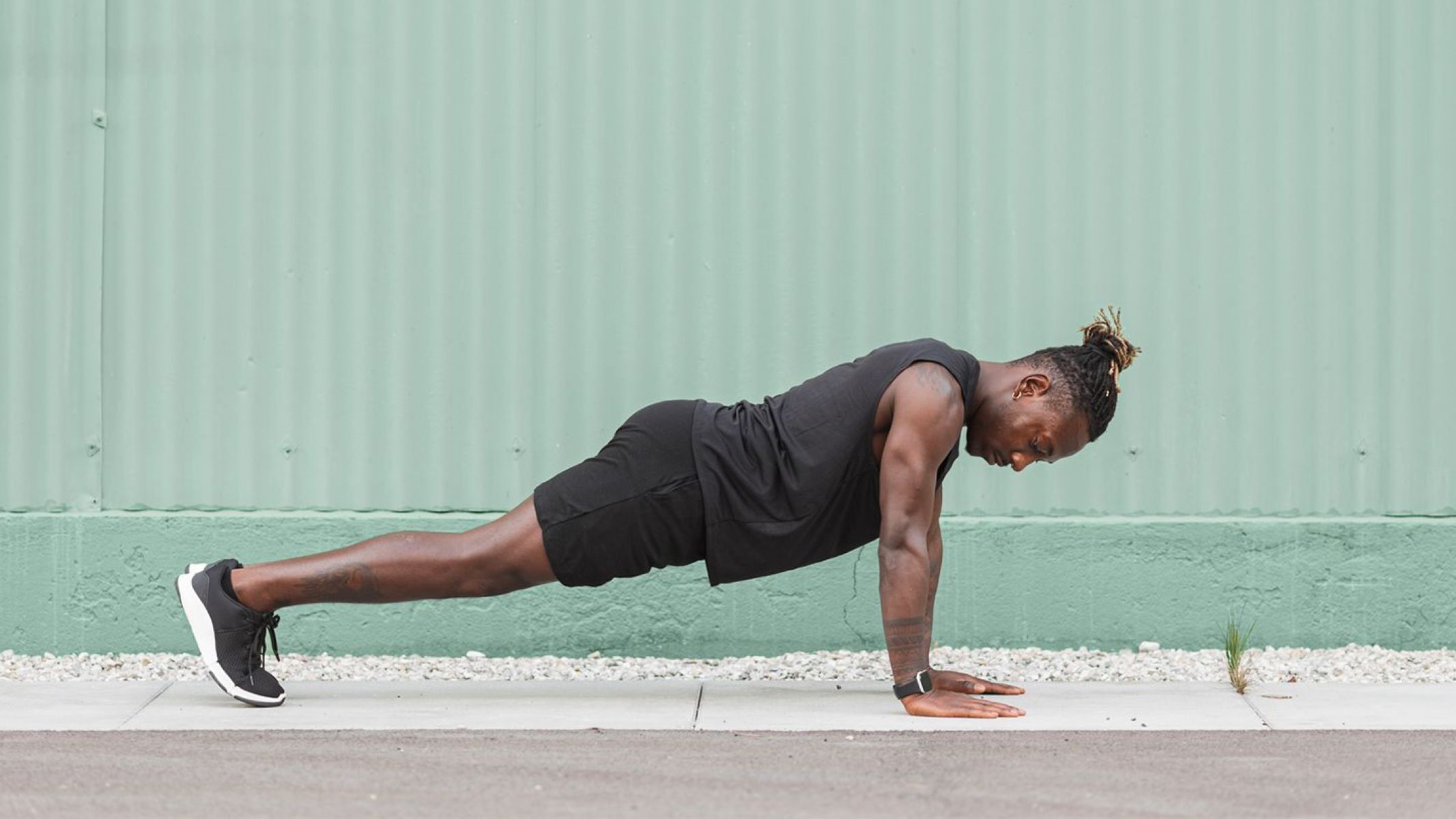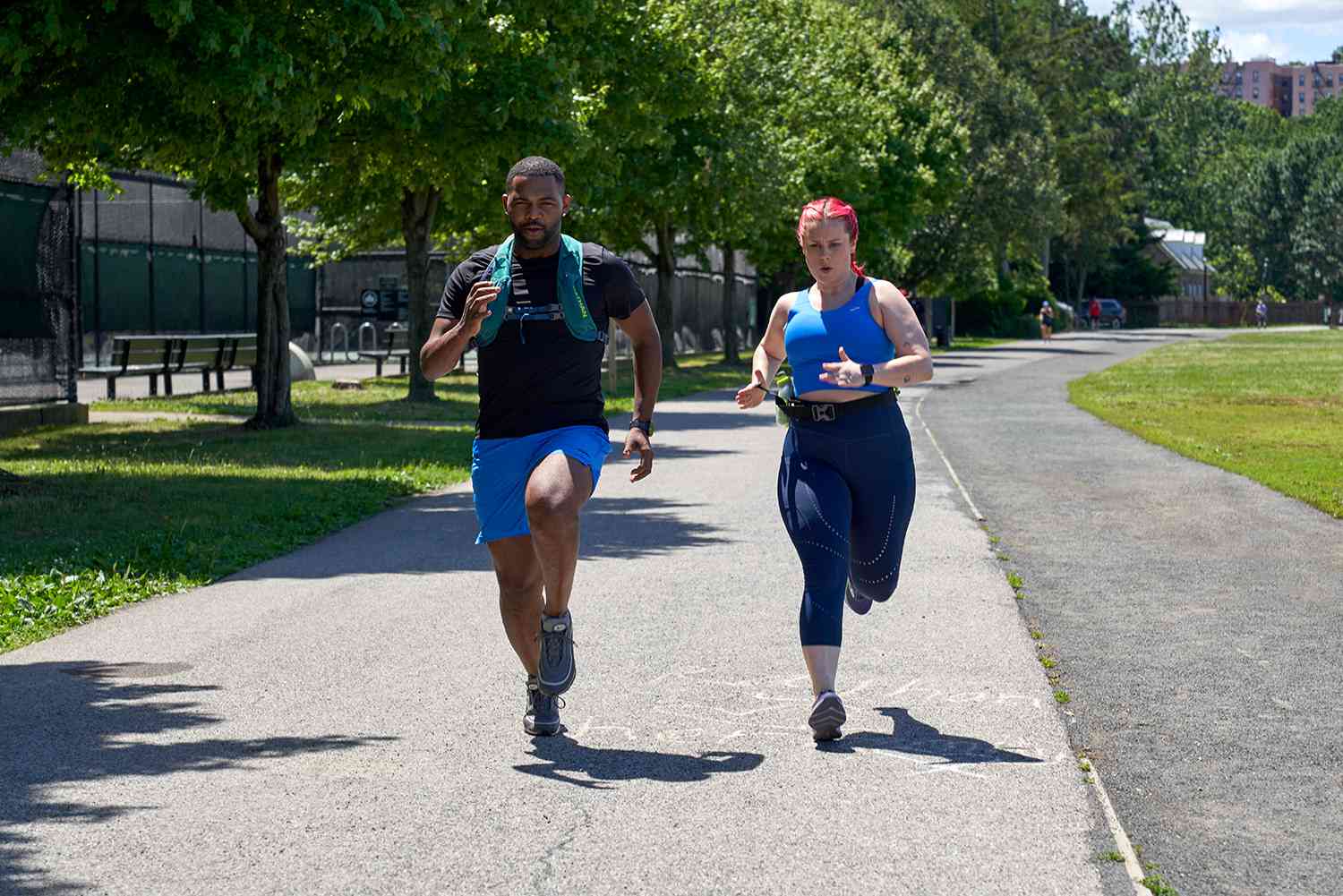Home>Misc>Featured>How Long Does It Take To See Results From Jogging


Featured
How Long Does It Take To See Results From Jogging
Modified: August 21, 2023
Discover how long it takes to see featured results from jogging. Explore the timeline for achieving fitness goals and maximizing your jogging efforts.
Introduction
Welcome to the world of jogging, a popular and effective form of exercise that can improve your physical fitness, mental well-being, and overall health. Whether you’re a beginner taking your first steps or a seasoned runner looking to improve your performance, it’s natural to wonder how long it will take to see results from jogging.
The truth is, the time it takes to see noticeable changes can vary from person to person, depending on several factors. These factors can include your current fitness level, genetics, the intensity and frequency of your workouts, and your overall lifestyle habits.
It’s important to approach your jogging journey with realistic expectations and a long-term mindset. While some individuals may experience immediate benefits, such as increased energy and improved mood, others may take longer to see physical changes like weight loss or muscle definition.
In this article, we will explore the different factors that can influence the timeline for seeing results from jogging. We will also provide tips on how to maximize your benefits and set yourself up for success on your jogging journey.
Factors Affecting Results from Jogging
When it comes to seeing results from jogging, it’s important to consider the various factors that can impact your progress. These factors can play a significant role in how quickly or slowly you notice changes in your body and overall fitness level.
1. Current Fitness Level: Your starting point will naturally influence the time it takes to see results. If you’re already physically active and have a moderate level of fitness, you may experience improvements more quickly. On the other hand, if you’re just starting out or have been inactive for a while, it may take a bit longer to notice significant changes.
2. Genetics: Each person’s body responds differently to exercise due to genetic factors. Some individuals may have a predisposition to building muscle or losing weight more rapidly, while others may find it takes more time and effort to achieve their desired results.
3. Intensity and Frequency of Workouts: The intensity and frequency of your jogging sessions can greatly impact your results. If you’re consistently challenging yourself with higher intensity workouts and running regularly, you’re more likely to see quicker improvements in areas such as cardiovascular fitness and muscle strength.
4. Nutrition and Diet: Your eating habits and overall nutrition play a vital role in supporting your jogging efforts. A well-balanced diet that provides the necessary nutrients, including protein for muscle repair and carbohydrates for energy, can speed up your progress. On the other hand, poor nutrition can hinder your results.
5. Rest and Recovery: Giving your body enough time to rest and recover is crucial for seeing optimal results. Proper rest allows your muscles to repair and grow stronger. Overtraining or not allowing enough recovery time can lead to fatigue, decreased performance, and an increased risk of injury.
6. Lifestyle Habits: Factors such as adequate sleep, stress management, and avoiding unhealthy habits like smoking or excessive alcohol consumption can also impact your progress. These lifestyle choices can directly affect your energy levels, recovery ability, and overall well-being, ultimately influencing the time it takes to see results.
By understanding these factors and how they relate to your own circumstances, you can set realistic expectations and make informed decisions about your jogging routine. Remember, everyone’s journey is unique, and comparing yourself to others may not be productive. Focus on your own progress, stay consistent, and celebrate each milestone along the way.
Physical Changes
One of the most visible and tangible results from jogging is the physical changes that occur in your body. Regular jogging can have a profound impact on your overall physique and can help you achieve a leaner and more toned appearance. Here are some of the physical changes you may experience:
1. Weight Loss: Jogging is an excellent form of cardiovascular exercise that can help you burn calories and shed excess weight. By consistently engaging in jogging sessions, you can create a calorie deficit, leading to weight loss over time. The amount of weight you can expect to lose will vary depending on factors such as your current weight, diet, and exercise intensity.
2. Muscle Definition: Jogging primarily targets the lower body muscles, including the quadriceps, hamstrings, calves, and glutes. Over time, as you continue to jog, these muscles will strengthen and become more defined. You may notice increased muscular endurance and a more sculpted appearance in your legs and buttocks.
3. Improved Posture: Regular jogging can also improve your posture by strengthening the core muscles that support your spine. As your core muscles become stronger and more balanced, you may find yourself standing taller and with better alignment.
4. Increased Stamina: Jogging is an excellent way to improve cardiovascular fitness and endurance. As you continue to jog, you’ll notice that you can run for longer distances or at a faster pace without getting as winded or fatigued. This increase in stamina will not only benefit your jogging performance but also improve your overall physical fitness levels.
5. Stronger Bones: Jogging is a weight-bearing exercise that places stress on your bones, which can help increase bone density and strength. This is particularly important for preventing conditions such as osteoporosis and reducing the risk of fractures.
6. Improved Body Composition: Jogging can help improve your body composition by reducing body fat percentage and increasing lean muscle mass. This can result in a more proportionate and aesthetically pleasing physique.
It’s important to note that the rate at which you experience these physical changes will vary from person to person. Factors such as your genetics, body composition, and exercise routine will influence the speed and extent of your transformation. Remember to be patient and consistent with your jogging routine to maximize the physical benefits.
Weight Loss
One of the key benefits of jogging is its effectiveness in promoting weight loss. If your goal is to shed those extra pounds, jogging can be a powerful tool to help you achieve and maintain a healthy weight. Here’s how jogging can contribute to weight loss:
Calorie Burn: Jogging is a high-impact cardiovascular exercise that activates multiple muscle groups and elevates your heart rate. This increased energy expenditure leads to the burning of calories. The number of calories burned during a jogging session depends on various factors, including your weight, speed, and duration of the run. On average, a 30-minute jog can burn around 300-400 calories.
Creating a Caloric Deficit: To lose weight, you need to consume fewer calories than you burn. By incorporating jogging into your routine and making healthy dietary choices, you can create a calorie deficit. This means that your body will start using stored fat as an energy source, leading to gradual weight loss over time.
Boosting Metabolism: Regular jogging can rev up your metabolism, leading to increased calorie burning even after your workout. This is known as the afterburn effect or excess post-exercise oxygen consumption (EPOC). Jogging stimulates your metabolism, causing it to remain elevated for hours after your run, helping you burn more calories throughout the day.
Preserving Lean Muscle Mass: When trying to lose weight, it’s essential to preserve lean muscle mass. Jogging, especially when combined with strength training exercises, can help preserve muscle mass while promoting fat loss. This is important because muscle mass plays a crucial role in boosting metabolism and maintaining overall strength and mobility.
Overall Health Benefits: Jogging contributes to weight loss by improving overall health. Regular jogging can reduce the risk of chronic diseases such as heart disease, diabetes, and certain types of cancer. By maintaining good health, you’ll be able to engage in more physical activity, which further aids in weight loss.
While jogging can be an effective way to lose weight, it’s important to approach weight loss in a healthy and sustainable manner. It’s recommended to combine jogging with a balanced diet, adequate hydration, and strength training exercises for optimal results. Additionally, focus on making long-term lifestyle changes rather than relying solely on jogging for weight loss.
Remember, weight loss is a gradual process, and the rate at which you lose weight may vary depending on factors such as your starting weight, genetics, and adherence to a consistent jogging routine. Stay patient, stay consistent, and focus on the overall improvement in your health and well-being rather than solely on the numbers on the scale.
Cardiovascular Health
Jogging is an excellent form of cardiovascular exercise that can have a significant impact on your heart health. Consistent jogging can strengthen your cardiovascular system and provide numerous benefits for your overall cardiovascular health. Here are some ways in which jogging can improve your cardiovascular health:
Improved Heart Strength: When you jog, your heart has to pump oxygenated blood to your muscles at a faster rate. Over time, this constant demand for increased blood flow strengthens your heart muscles, making it more efficient at pumping blood throughout your body.
Lower Blood Pressure: Regular aerobic exercise such as jogging can help lower blood pressure levels. It promotes healthy blood flow, reduces the resistance in your blood vessels, and decreases the workload on your heart. This can help manage hypertension and reduce the risk of heart disease and stroke.
Reduced Risk of Cardiovascular Disease: Jogging has been shown to reduce the risk of developing cardiovascular diseases. Regular exercise can improve blood lipid profile by increasing the levels of high-density lipoprotein (HDL) cholesterol (“good” cholesterol) and reducing the levels of low-density lipoprotein (LDL) cholesterol (“bad” cholesterol) and triglycerides. This can lower the risk of atherosclerosis and plaque formation in the arteries.
Increase in VO2 max: VO2 max is a measure of your body’s ability to use oxygen during exercise. Regular jogging can improve your VO2 max, indicating improved cardiovascular fitness. This means your body becomes better at using oxygen to produce energy for your muscles.
Enhanced Lung Function: Jogging is a form of aerobic exercise that requires deep breathing. The increased demand for oxygen during jogging strengthens your respiratory muscles and improves lung capacity. This can result in better lung function and increased oxygen delivery to your body’s tissues.
Weight Management: Maintaining a healthy weight through regular jogging can have a positive impact on your cardiovascular health. Excess weight puts additional strain on your heart, increasing the risk of heart disease and other cardiovascular conditions. By jogging regularly, you can manage your weight, reduce body fat, and improve overall cardiovascular function.
Stress Reduction: The physical activity and release of endorphins during jogging can help reduce stress levels. High stress levels can have a negative impact on your cardiovascular health. By incorporating jogging into your routine, you can promote relaxation, improve mental well-being, and reduce the risk of stress-related heart problems.
It’s important to note that cardiovascular health improvements from jogging are cumulative and require consistency over time. Gradually increase the duration and intensity of your jogging sessions to challenge your cardiovascular system. As with any exercise program, consult with a healthcare professional if you have any underlying health conditions or concerns.
Muscle Strength and Endurance
Jogging is not only beneficial for cardiovascular health but also for building muscle strength and endurance. Regular jogging can help strengthen and tone your muscles, improve their endurance, and enhance overall physical performance. Here are some key ways in which jogging can contribute to muscle strength and endurance:
Lower Body Strengthening: Jogging primarily engages the lower body muscles, including the quadriceps, hamstrings, glutes, and calves. The repetitive motion of jogging helps to activate and work these muscles, leading to increased strength and muscle development over time.
Increase in Fast-Twitch Muscle Fibers: Jogging primarily utilizes slow-twitch muscle fibers, which are responsible for endurance-based activities. However, jogging at higher intensities can also recruit fast-twitch muscle fibers, which are associated with power and strength. By incorporating sprint intervals or uphill runs into your jogging sessions, you can further stimulate these fast-twitch muscle fibers and promote muscle strength development.
Improved Muscle Endurance: Consistent jogging can significantly improve muscle endurance. As you continue to jog, your muscles adapt and become more efficient at utilizing oxygen and energy. This leads to delayed muscle fatigue, allowing you to run for longer distances or extended periods, without feeling as quickly exhausted.
Enhanced Core Stability: Jogging engages the core muscles, including the abdominals and lower back, to maintain balance and stability. The repeated movement and activation of these muscles during jogging can help strengthen and stabilize your core, improving overall posture and reducing the risk of lower back pain.
Upper Body Toning: While jogging primarily targets the lower body, you can still engage and tone your upper body muscles. Pumping your arms with each stride can help strengthen the muscles in your shoulders, arms, and chest. To further engage your upper body, consider incorporating arm exercises or carrying light weights while jogging.
Improved Bone Density: Jogging is a weight-bearing exercise, which means it places stress on your bones. Weight-bearing exercises are essential for improving bone density. Regular jogging can help lower the risk of osteoporosis, a condition characterized by weakened bones, by stimulating the production of new bone tissue and promoting bone health.
To maximize muscle strength and endurance gains from jogging, gradually increase the intensity and distance of your runs. Incorporate strength training exercises, such as squats and lunges, into your weekly routine to further enhance muscular development. Be sure to allow for proper recovery between jogging sessions to allow your muscles to repair and grow stronger.
Remember, muscle development and endurance improvements take time and consistency. Embrace the journey, listen to your body, and enjoy the many physical benefits that jogging has to offer.
Mental Health Benefits
While jogging is well-known for its physical benefits, it also offers a multitude of mental health advantages. Engaging in regular jogging can have a profound impact on your psychological well-being and overall mental health. Here are some key mental health benefits of jogging:
Stress Reduction: Jogging is an excellent way to reduce stress and promote relaxation. When you jog, your body releases endorphins, also known as “feel-good” hormones, which can help improve your mood and alleviate stress. The rhythmic motion of jogging can also provide a meditative experience, allowing you to clear your mind and focus on the present moment.
Improved Mood and Mental Well-being: Jogging has been shown to have a positive impact on mood and mental well-being. Regular physical activity, including jogging, stimulates the release of neurotransmitters such as serotonin and dopamine, which are associated with feelings of happiness and pleasure. Jogging can act as a natural antidepressant and help alleviate symptoms of depression and anxiety.
Boost in Self-Confidence: Engaging in jogging and achieving personal fitness goals can significantly boost self-confidence. As you gradually increase your jogging distance or improve your pace, you’ll experience a sense of accomplishment and pride in your abilities. This increased self-confidence can extend beyond your jogging routine and positively impact other areas of your life.
Enhanced Cognitive Function: Physical exercise, including jogging, has been shown to enhance cognitive function and improve mental clarity. The increased blood flow and oxygen delivery to the brain during exercise can enhance focus, memory, and overall cognitive performance. Regular jogging can help sharpen your mental acuity and promote better concentration and productivity.
Stimulation of Creativity: Jogging has been found to promote creative thinking. As you jog and engage in physical activity, your mind is free to wander, and new connections can be formed. This can lead to new ideas and inspiration, making jogging an excellent way to stimulate creativity and overcome mental blocks.
Social Interaction: Jogging can provide opportunities for social interaction and connection. Joining a jogging group or participating in organized races allows you to meet like-minded individuals who share your passion for running. Socializing while jogging can foster a sense of community and support, reducing feelings of isolation and improving overall mental well-being.
Improved Sleep: Regular jogging can contribute to better sleep quality. Exercise, including jogging, can help regulate sleep patterns and promote deeper and more restful sleep. By reducing stress, improving mood, and increasing physical tiredness, jogging sets the stage for a good night’s sleep, leading to enhanced mental and emotional well-being.
Jogging provides a powerful avenue for improving mental health and achieving overall well-being. Remember, consistency is key when it comes to reaping the full mental health benefits of jogging. Make it a habit to incorporate jogging into your routine and listen to your body’s needs. Enjoy the mental clarity, uplifted mood, and increased self-confidence that jogging can bring into your life.
Improvements in Sleep
Getting a good night’s sleep is essential for overall health and well-being, and jogging can play a significant role in improving the quality and duration of your sleep. Engaging in regular jogging can have numerous benefits for sleep, leading to a more restful and rejuvenating experience. Here’s how jogging can contribute to improvements in sleep:
Stress Reduction: Jogging helps reduce stress levels, which can often interfere with sleep. Physical activity releases endorphins, promoting relaxation and reducing anxiety and tension that may disrupt sleep. By incorporating jogging into your routine, you can find an outlet for stress and promote a more peaceful state of mind, allowing for better sleep.
Regulation of Circadian Rhythm: Jogging outdoors exposes you to natural light, which plays a crucial role in regulating your body’s circadian rhythm. Regular exposure to natural light during daytime jogging can help reset your internal body clock, promoting a more regular sleep-wake cycle. A well-regulated circadian rhythm can make it easier to fall asleep at night and wake up feeling refreshed in the morning.
Increased Physical Fatigue: Regular jogging can help increase physical fatigue, making it easier to fall asleep at night. The physical exertion from jogging stimulates the body and relaxes the muscles, creating a greater need for rest and sleep. This can improve sleep efficiency, allowing you to fall asleep faster and stay asleep longer.
Enhanced Sleep Quality: Jogging promotes deeper and more restorative sleep. The rhythmic movement and increased heart rate from jogging can help regulate sleep cycles and enhance the quality of your sleep. Deep sleep phases, known as slow-wave sleep, are important for physical recovery and mental rejuvenation, and jogging can contribute to achieving these restorative sleep stages.
Reduction in Sleep Disorders: Regular exercise, including jogging, has been linked to a reduced risk of sleep disorders such as insomnia and sleep apnea. Jogging can improve the overall sleep architecture, leading to less fragmented sleep and fewer disruptions throughout the night. By incorporating jogging into your routine, you may experience a decrease in sleep-related issues.
Increased Daytime Alertness: When you have a restful night’s sleep, you wake up feeling refreshed and more alert during the day. Regular jogging can contribute to better sleep patterns, leading to increased daytime alertness and productivity. By engaging in physical activity, you provide a natural energy boost that supports healthy wakefulness throughout the day.
It’s important to note that the timing of your jogging sessions can influence sleep. Try to avoid rigorous exercise too close to bedtime, as it may energize your body and make it harder to fall asleep. Aim to finish jogging at least a few hours before you plan to go to bed to allow your body to cool down and unwind before sleep.
By incorporating regular jogging into your routine, you can enjoy the benefits of improved sleep quality, reduced stress, and increased daytime alertness. Remember to listen to your body, maintain a consistent jogging routine, and create a sleep-friendly environment to optimize the positive effects of jogging on your sleep.
Tips for Maximizing Results
To make the most of your jogging routine and maximize the results, it’s important to approach it with intention and incorporate effective strategies. Whether you’re a beginner or a seasoned runner, these tips can help you optimize your jogging experience and achieve your desired goals:
1. Set Realistic Goals: Start by setting realistic and achievable goals for your jogging routine. Whether it’s improving your endurance, increasing your jogging distance, or reaching a specific pace, having clear goals can keep you motivated and focused on your progress.
2. Follow a Structured Training Plan: Consider following a structured training plan that gradually increases the intensity and duration of your jogging sessions. This can help prevent overexertion, reduce the risk of injury, and ensure a progressive improvement in performance.
3. Vary Your Workouts: Mix up your jogging routine by incorporating different types of workouts. Include interval training, tempo runs, hill sprints, or long steady runs to challenge different muscle groups and improve overall fitness. Varying your workouts can also help prevent boredom and plateauing.
4. Listen to Your Body: Pay attention to your body’s signals and adjust your jogging routine accordingly. If you feel pain or excessive fatigue, take a rest day or opt for low-impact activities. Pushing through pain can lead to injuries and setbacks. Rest and recovery are just as important as the workouts themselves.
5. Supportive Footwear and Proper Form: Invest in a pair of well-fitting, supportive running shoes that suit your foot type and running style. This can help prevent injuries and provide optimal comfort during your jogging sessions. Additionally, focus on maintaining proper running form, including a slight forward lean, relaxed shoulders, and a midfoot strike.
6. Stay Hydrated and Fuel Your Body: Hydration is essential for optimal performance and recovery. Drink plenty of water before, during, and after your runs. It’s also important to nourish your body with a balanced diet that includes carbohydrates for energy, protein for muscle repair, and healthy fats for overall well-being.
7. Incorporate Strength Training: Include strength training exercises in your routine to complement your jogging. Strengthening your muscles through resistance training can improve running efficiency, prevent muscle imbalances, and enhance overall performance. Focus on exercises that target the major muscle groups, including squats, lunges, and core exercises.
8. Prioritize Rest and Recovery: Allow for adequate rest and recovery between your jogging sessions. This includes getting enough sleep, which is crucial for muscle repair and overall well-being. Incorporating activities such as stretching, foam rolling, and gentle cross-training can also help reduce muscle soreness and improve recovery.
9. Track Your Progress: Keep a record of your jogging sessions to monitor and track your progress. This can help you see how far you’ve come, identify patterns or areas for improvement, and stay motivated to reach your goals. Consider using a running app or a journal to log your workouts, distance, time, and any other relevant details.
10. Enjoy the Journey: Lastly, remember to enjoy the process of jogging and appreciate the benefits it brings to your physical and mental well-being. Find joy in the feeling of movement, the sense of accomplishment, and the opportunity to explore new places. A positive mindset and genuine enjoyment of jogging can fuel your motivation and make it a sustainable part of your lifestyle.
By incorporating these tips into your jogging routine, you can optimize your efforts and make the most of your workouts. Remember, every individual is unique, so it’s important to find what works best for you and listen to your body along the way. Happy jogging!
Conclusion
Jogging is a powerful form of exercise that offers a wide range of physical and mental health benefits. From improving cardiovascular health and muscle strength to promoting weight loss and better sleep, jogging can enhance overall well-being and quality of life. By understanding the factors that affect results from jogging and implementing effective strategies, you can maximize the benefits and achieve your goals.
It’s important to approach jogging with a long-term mindset and set realistic expectations. Results may vary from person to person, and patience and consistency are key. Each individual’s journey is unique, and it’s important to focus on your personal progress rather than comparing yourself to others.
Remember to listen to your body and adjust your jogging routine accordingly. Rest and recovery are just as important as the workouts themselves. Take care of your physical health by wearing proper footwear, practicing good form, and incorporating strength training exercises to support muscle development and prevent imbalances.
Jogging not only benefits your physical health but also has a positive impact on your mental well-being. It can reduce stress, improve mood, boost self-confidence, and stimulate creativity. The mental health benefits, coupled with the physical improvements, make jogging a holistic and effective form of exercise.
Incorporate these tips into your jogging routine: set realistic goals, follow a structured training plan, vary your workouts, listen to your body, stay hydrated, and prioritize rest and recovery. Track your progress, stay motivated, and enjoy the journey of self-improvement and personal growth.
So, lace up your running shoes, embrace the fresh air, and let jogging become a regular part of your life. Experience the transformative power of this simple yet powerful exercise as you witness positive changes in your physical fitness, mental well-being, and overall health.








